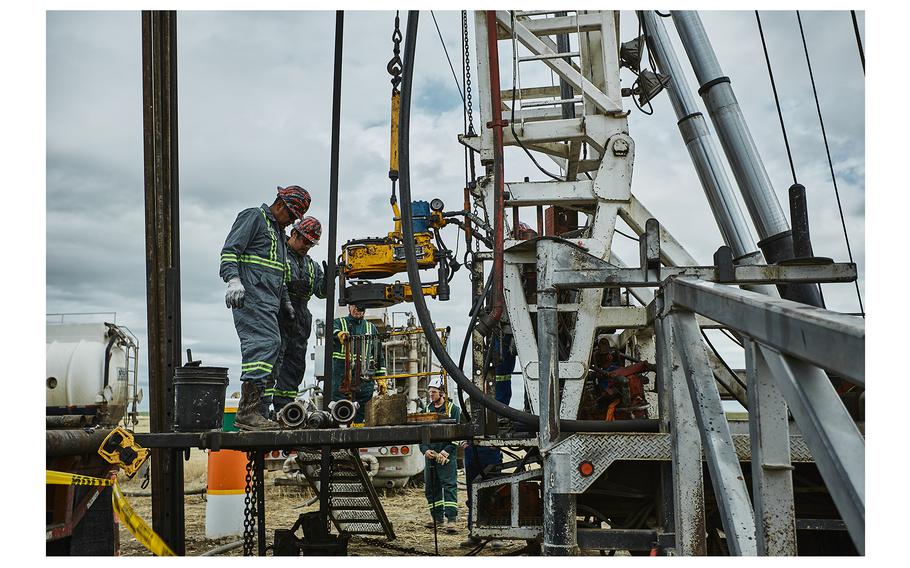
Workers operate a drilling rig while plugging an abandoned oil well north of Shelby, Mont. (Adrián Sanchez-Gonzalez for The Washington Post)
Oil and gas companies face at least a tenfold increase in costs to drill on federal lands under a Biden administration rule aimed at generating more money for taxpayers and protecting them from cleanup costs.
The rule released Friday represents the first comprehensive update to the federal oil and gas leasing program in more than 30 years. It comes as the United States pumps more crude oil than any other country in history - an uncomfortable fact facing President Biden as he touts his ambitious climate agenda on the campaign trail.
The move by the Interior Department’s Bureau of Land Management will require oil companies to pay $150,000 per lease on federal lands, up from $10,000. It marks the first time the so-called bonding requirement has been updated since 1960, despite significant inflation.
For the first time in a century, fossil fuel companies will also have to pay more in royalties for the oil and gas they extract from federal lands, based on the total revenue received. Under the new rule, the minimum royalty rate the government is paid will rise to 16.67 percent from 12.5 percent of revenue. That percentage is more in line with higher rates charged by most private landowners and major oil- and gas-producing states.
The rule comes as the Biden administration readies a sweeping plan to limit future oil drilling across roughly 13 million acres of the National Petroleum Reserve-Alaska, the nation’s largest expanse of public land. Bloomberg News first reported that the Interior Department is expected to finalize the plan - another key plank of the president’s conservation agenda - in the coming days.
Supporters say the changes announced Friday will better compensate taxpayers for fossil fuel extraction on federal lands, and that they will prevent taxpayers from footing the bill for cleanup of abandoned oil and gas wells. After ending their drilling operations or going out of business, fossil fuel companies have walked away from thousands of wells, leaving the sites leaking greenhouse gases and toxic substances such as arsenic and benzene.
The bipartisan infrastructure law of 2021 provided a record $4.7 billion for states’ efforts to plug these “orphan” wells. But the federal funding may make only a small dent in the problem, with some experts estimating that there could be millions of undiscovered orphan wells across the country.
“There are costs of doing business, and the industry should shoulder the costs of cleanup for their operations,” said Autumn Hanna, vice president of Taxpayers for Common Sense, a nonpartisan watchdog group. “They’re extracting oil and gas from public lands for their own profit, and those resources are owned by taxpayers, who should not be left to shoulder the cleanup costs themselves.”
Kate Groetzinger, communications manager at the Center for Western Priorities, a conservation group, said the changes are “only fair” after the country’s largest oil and gas companies reported their biggest annual profits in a decade last year. ExxonMobil reported $36 billion in earnings, while Chevron netted $21.4 billion.
“They make huge profits and then leave taxpayers holding the bag,” Groetzinger said of such firms.
Fossil fuel industry trade groups, for their part, voiced strong concerns about the BLM’s proposed rule released last summer. In public comments, a coalition of 14 trade associations wrote that the proposal could hamper domestic fossil fuel production, making America more reliant on other countries for its energy needs.
“We are concerned that BLM’s approach with this rule overreaches its statutory authority and could have a damaging impact on U.S. energy security and the economy,” wrote the groups, including the American Petroleum Institute and the Independent Petroleum Association of America.
Dan Naatz, executive vice president of the Independent Petroleum Association of America, previously told The Post that the proposed rule would make it harder for smaller oil and gas firms to drill on public lands.
“I don’t know any company that just wants to speculate or just sit on leases,” Naatz said. “The goal is to produce.”
Friday’s rule codifies provisions in Biden’s signature climate law, the Inflation Reduction Act. It also directs oil companies to prioritize leasing in areas with existing energy infrastructure and high production potential, rather than areas with sensitive wildlife habitat or cultural resources.
In addition to overhauling fossil fuel production on federal lands, the administration has sought to boost renewable energy development on these tracts. On Thursday, the Interior Department announced that it has approved permits for nearly 29 gigawatts of clean energy - enough to power more than 12 million homes. The figure includes dozens of solar farms, wind turbines and geothermal projects.
Also on Thursday, Interior finalized a rule that will reduce the rents and fees that renewable energy developers pay to use public lands. The rule will slash these payments by around 80 percent compared with the previous requirements in place since 2022.
Interior Secretary Deb Haaland said on a call with reporters that the Biden administration has approved more than double the number of renewable energy projects than the Trump administration did. She suggested that former president Donald Trump, who has criticized wind power as excessively costly and falsely claimed that wind turbines cause cancer, had slowed - but not stopped - the nation’s shift away from fossil fuels.
“The previous administration did everything they could to hobble our department’s clean-energy program, but we’re making up for lost time as we focus on this urgent and overdue transition to a better future,” Haaland said.